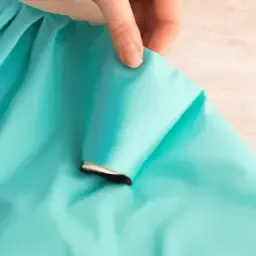This site is supported by our readers. We may earn a commission, at no cost to you, if you purchase through links.
Hemming a satin dress can be a daunting task, especially if you’ve never done it before. But with the right tools, techniques, and a little bit of patience, it’s a lot easier than you might think. In this article, we’ll take you through the step-by-step process of hemming a satin dress to perfection.
Table Of Contents
Table of Contents

Tools and Materials Needed
Before starting, you’ll need to gather some essential tools and materials: Sewing machine
Preparing the Dress

Measuring and Marking
Once you’ve decided on the length of the hem, it’s time to start measuring and marking. Lay the dress on a hard floor or round table top, making sure it’s flat and smooth. Measure the hem from the bottom of the dress, using a ruler or measuring tape. Mark the hemline with chalk or a washable marker, making sure it’s straight and even.
Next, you’ll need to mark the excess hem allowance. This is the amount of fabric that you’ll fold up and sew to create the hem. The excess hem allowance should be around 2 inches for a floor-length satin gown.
Measure and mark the excess hem allowance all the way around the dress, using a ruler or measuring tape.
Cutting the Hem

Then, fold the excess hem allowance up and pin it in place, using straight pins.
Sewing the Hem
To sew the hem, you’ll need to use a sewing machine or serger. If you’re using a sewing machine, set it to a medium stitch length, around 2.5mm. Use a matching thread color and start sewing along the hemline, making sure to catch both the outer layer and lining layer of the dress.
If you’re using a serger, set the blade to the left position and the stitch length to 2mm. Serge along the hemline, making sure to catch both the outer layer and lining layer of the dress.
Finishing Touches

Conclusion
Hemming a satin dress can be a tricky task, but with the right tools and techniques, you can achieve a flawless finish. By following the steps outlined in this article, you’ll be able to hem your satin dress like a pro.
Frequently Asked Questions (FAQs)
Can I hem a satin dress by hand?
Yes, you can hem a satin dress by hand, but it will take longer and may not be as neat as using a sewing machine.
Do I need a serger to hem a satin dress?
No, you don’t necessarily need a serger to hem a satin dress, but it can make the process faster and give the hem a more professional finish.
Can I hem a satin dress without cutting the excess fabric?
No, you need to cut the excess fabric to create the hem. Otherwise, the hemline will not be even.
How do I prevent the fabric from puckering while hemming?
To prevent the fabric from puckering, use a sharp needle and make sure the tension on your sewing machine is set correctly.
How long does it take to hem a satin dress?
- The time it takes to hem a satin dress depends on the length of the dress and the tools you’re using.






